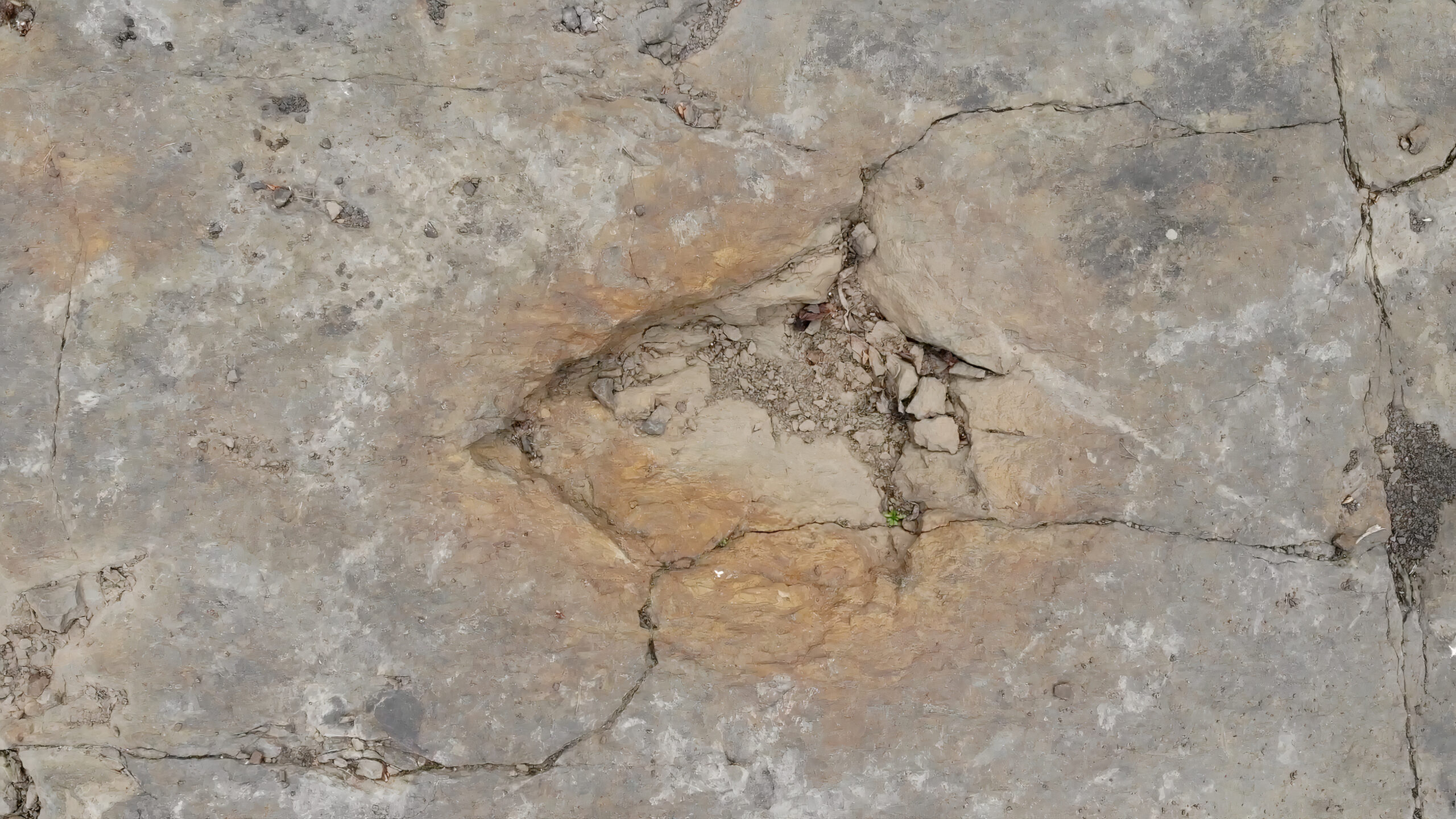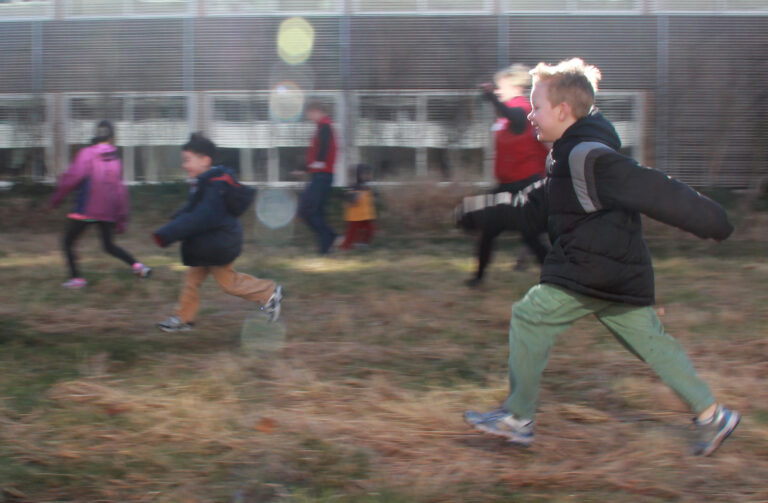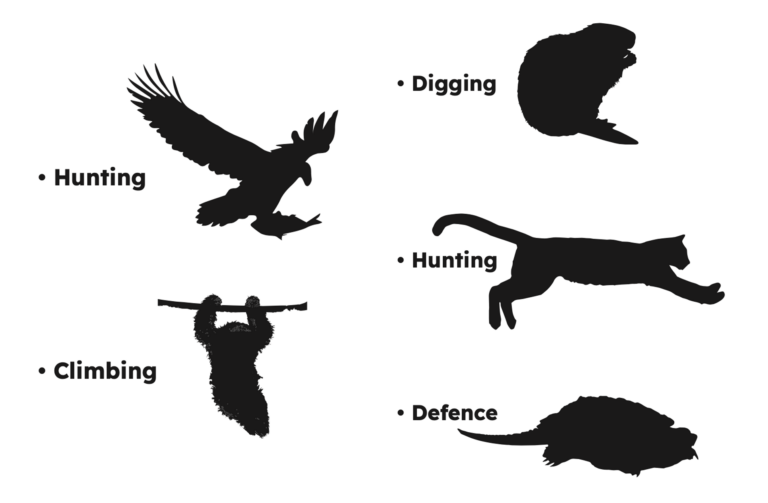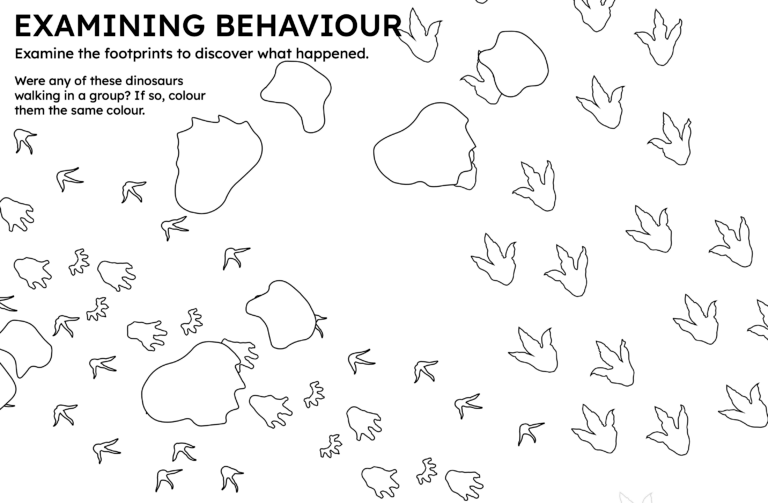Forest Footprints
Huge dents in the rock are actually footprints of sauropods, the largest dinosaurs to ever live. Four-clawed footprints belong to therizinosaurs, an unusual plant-eating theropod. What other discoveries will be made here?
Questions to keep in mind
- How were the footprints uncovered?
- What kinds of dinosaurs left traces in the rock?
- How many footprints are still to be found here?
Sauropod size
With the mass of 10 elephants, sauropods were the heaviest, largest dinosaurs to roam the Earth. Their giant footprints were found at this site.
Walking with dinosaurs
The tiny dots below are people. Sauropods never lived during the same time as humans. But here’s how big a sauropod would be walking next to the folks clearing the footprints.
Big foot
This is the back footprint of a sauropod. Their back feet had five toes, but only three had claws. Can you see the claw marks?

Front foot or back foot?
A sauropod’s front foot was a different shape than its back foot. This can be very helpful when trying to figure out how they walked.

How big were sauropods?

Is there more to find?
This fossil site contains hundreds of 115-million-year-old footprints from all kinds of dinosaurs. More footprints are still covered by the forest.
Tracking dinosaurs
Lisa says there are many different dinosaur trackways here. The smaller footprints are from theropods and ornithopods. Can you see the large, triangular footprints made by sauropods?

Dig deeper
These footprints were covered by soil and plants. Many people worked to clear the area. The footprints are clear enough that we can tell what types of dinosaurs were here and how big they were.
Richard: Footprints are found in a variety of depositional environments, and it’s just like any other thing. For footprints, modern footprints, you have a human footprint and you walk on certain substrates like sand or a mud, firm sand, wet sand. You name it.
Ariel view of a fossil track site, an exposed rocky patch of ground with blue tarps strewn around it. Several people sit on the ground looking at the tracks. The camera slowly pans over the length of the site.
Lisa: That footprint is gonna look different.
Richard: It is. Sometimes it’s not gonna look like much at all. You’re not even going to be able to see toes.
Sizing up
It’s difficult to tell exact size from footprints. The dinosaurs found here might have been this big if you were standing next to them.
Make tracks

Therizinosaurs are unusual
Even though they are related to theropods, we think they are herbivores and not carnivores! Their long, sharp claws may have been for defense.
How did they look?
We know from body fossils that therizinosaurs were covered in feathers. Do therizinosaurs remind you of birds in any other way?
We're sorry! 3D content is only available when Javascript is enabled.


to explore
in and out
Unique footprints
There are four very pointy toes in this footprint, in which moss and other plants have grown. This makes therizinosaur footprints distinctive, even in a field of hundreds of footprints.
We're sorry! 3D content is only available when Javascript is enabled.


to explore
in and out
A four-toed footprint fossilized in greyish-brown rock. The four toes are widely splayed each with a pointy tip that indicates claws. The impression is filled with green moss and tiny rocks.
Form and function
Bird and dinosaur feet are similar. We can learn about behaviour such as feeding from the shape of the feet and claws.
Three bird feet are lined up: a goose’s foot with small rounded claws and webbing between its toes; A black raven’s foot, small in comparison to the other two with pointy hooked claws; and an eagle’s foot with large talons and long pointy claws.
Ildiko: So one of the questions that I was asked today is: if I saw bird footprints, would I have an idea of what it liked to eat? And I would say very much. So I would know that if I saw webbing that this is a bird that preferred aquatic habitats, and that it’s probably a herbivore, a vegetarian, or an omnivore. If I saw the middle foot of the raven, I would know that this is a bird that likes to cling on branches, and again, it’s probably a generalist and likes to eat all sorts of things. But if I saw the eagle foot, I would see all the power, and I would know it’s a carnivore. My name is Ildiko Szabo. I’m the collections curator of the Cowan Tetrapod Collection here at the UBC Beaty Biodiversity Museum.
A woman with grey chest-length hair and glasses looks at the camera.
Comparing claws

Teamwork pays off
What do dinosaurs, birds—their modern descendants, and people have in common? Sometimes they work together! We can see that in their behaviour
Piece of the puzzle
There are many footprints here including this sauropod footprint. What can we learn from many footprints that we couldn’t learn from just one? Do you think the sauropod interacted with any of the other dinosaurs?
Aerial shot looking down at a greyish-brown rocky ground. There are several people sitting down. The camera slowly moves in getting closer to the ground. Holes in the ground become more noticeable. Eventually one takes up most of the frame and we see it is a big sauropod footprint.
Richard: When you study tracks and trackways, you’re seeing the actions of animals that were alive when they made those traces. So you’re getting a lot of an idea of how the animals used their anatomy, what other animals they’re walking around with, and what environments they were frequenting. And you know what kinds of behavior they had, whether they were traveling in groups or singly, or all kinds of things that you just can’t get from bones.
Walk beside me
Lisa and Richard found multiple theropod tracks here which all move in the same way, parallel to each other. From this, they think that the dinosaurs were walking in a group. Where do you think they were going?
Better together
Many dinosaur footprints were found at this site. What do you think they were doing together? We can look at bird behaviour to get some clues.
A big flock of gulls and royal terns gather on the beach.
Ildiko: Birds do many, many things in large groups. They gather when there’s a lot of food in one particular area, and there’ll be a lot of individuals of one species, plus multiple species.
Swans and geese swim together in the water. Gulls sleep together standing in shallow water.
Ildiko: They also like to sleep together in large groups. This is to avoid predation. And the ones on the outside of the group act as sentinels, yelling if they perceive an intruder.
Crows roost in a tree. A large flock of birds flies over a lake.
Ildiko: And birds, often when they’re nesting, they like a particular area that they find very safe or has lots of nesting possibilities. And again, they’re in very large groups.
Two American coots build a nest. Many albatrosses nest together in an open field.
Ildiko: My name is Ildiko Szabo. I’m the collections curator of the Cowan Tetrapod Collection here at the UBC Beaty Biodiversity Museum.
A woman with grey chest-length hair and glasses looks at the camera.
Examining behaviour

Geo facts | Cycling back to it
There is a cyclical nature to both rocks and life. Rocks are recycled by geological processes. Living things are recycled by biological processes. But what are some of the ways they are connected?
Soil and sediment
The forest and vegetation around this site depend on the soil to grow. Soil starts as rocks. The same ones that contain dinosaur footprints. So, what makes the soil different from rock?
An image of rocky debris is shown next to an image of dark brown dirt.
Sam: What is the difference between sediment and soil? Sediments are deposits made up of broken pieces of bigger rocks, like sand or gravel.
Magnified many times, sand looks like tiny yellow rocks. From a regular distance we can see the many fine particles making up the sand.
Sam: Soil is special. Soil is a type of living deposit where water, plants, animals, and microorganisms all work together to change the rocks around them.
Several images flash by quickly. A puddle of water on top of soil. Green sprouts emerge from damp soil. A pink worm lays curled on top of some dirt. A microscopic images of soil microbes. A soil profile showing different soil horizons.
Sam: Soil forms from rock and we call this rock the parent material. Any type of rock can become a parent material. Parent material on the Earth's surface is exposed to water. This water can trickle through tiny cracks, opening spaces for plant roots to take hold. The water also changes the rock through chemical reactions that breaks it down into smaller pieces.
Animation. Water rains down on the parent material. The parent material starts to crack and weather. Small plants start to grow, their roots spreading down into the parent material. This creates the c horizon made of weathered rock.
Sam: As more rock is broken down larger plants start to grow on top. Dead plant matter falls to the ground and it makes a deposit called humus, a mix of weathered rock and organic matter.
The parent material break down further. Larger plants start to grow in it. Humus builds up on the top. The A horizon of the soil starts to form.
Sam: Over a very long time as water continues to seep down through the soil. The layers of weather rock just underneath the humus go through so many chemical changes that it becomes the simplest rock type, clay. The result is a soil with distinct layers or horizons.
It continues to rain. The water drips down through the A horizon and starts to form the B horizon. The B horizon is made up of clay. The A B and C horizons stack on top of each other creating a soil profile.
Heat and pressure
The surrounding area is rich in coal. Coal is a special type of rock that formed from plants that died a long time ago. Even before the dinosaurs! How did that happen?
Arial shot looking down onto the fossil site.
Sam: Today this area is rich in coal deposits, but what can this tell us about the past?
Exposed layers of black coal are visible, sandwiched in between other rocks.
Sam: Coal is made up of carbon which comes from organic matter. All living things are made up of organic matter.
Animation. A zoomed in image of a carbon atom. The atoms start to multiply. The camera zooms out to reveal a plant filled swamp 300 million years ago. Some plants die and new ones take their place.
Sam: So when living organisms die, they leave behind a layer rich in carbon, but with lots of impurities. Normally, organic matter breaks down easily. However, if it's buried in conditions with no oxygen, it can form a thick layer of preserved plant matter called peat.
The dead plants build up on the ground and create a thick layer. 100 million years ago the sea level rises over the swamp. Other sediments start to build up on top of the peat. The peat is squeezed underneath the new sediments.
Sam: As new sediments get deposited on top, the pressure and heat cause the peat to undergo chemical reactions. This removes some of the impurities and leaves behind even more carbon rich material called lignite.
The sea level falls and the ground above the lignite is no longer under water. The lignite continues to be squeezed even further.
Sam: With even more heat and pressure, most of the impurities are removed from the lignite. What's left behind is a deposit that is almost pure carbon. That is what we call coal.
Footnotes on foothills
Ever wish you were taller? These foothills might be able to relate, even though they’re still considered part of the mountains.
The camera pans across a mountainous landscape. Orange lines highlight the smaller tree covered foothills that are nearby. Yellow lines highlight the tall snowy peaks in the distance.
Sam: Tectonic forces create mountain ranges, but mountains don't just pop up in the middle of a flat field. The highest peaks are found in the main ranges of a mountain chain. As you move further away from these peaks, you find smaller peaks and hills. These are called foothills. Foothills are usually the youngest part of the mountain range. Tectonic forces just started to push them up, but over time, they might become just as high as the main ranges.







